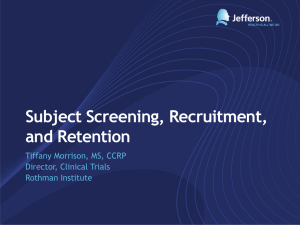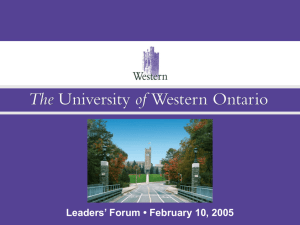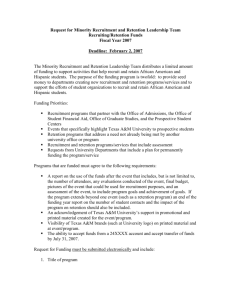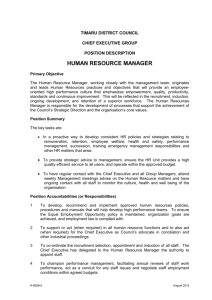Document 10465270
advertisement
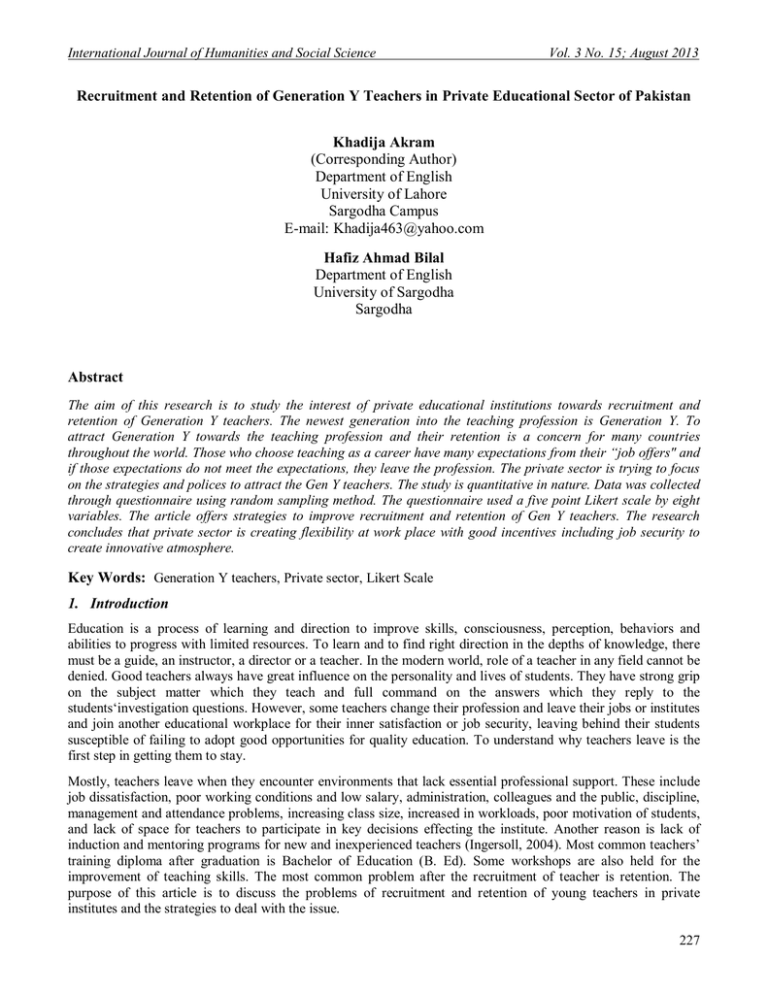
International Journal of Humanities and Social Science Vol. 3 No. 15; August 2013 Recruitment and Retention of Generation Y Teachers in Private Educational Sector of Pakistan Khadija Akram (Corresponding Author) Department of English University of Lahore Sargodha Campus E-mail: Khadija463@yahoo.com Hafiz Ahmad Bilal Department of English University of Sargodha Sargodha Abstract The aim of this research is to study the interest of private educational institutions towards recruitment and retention of Generation Y teachers. The newest generation into the teaching profession is Generation Y. To attract Generation Y towards the teaching profession and their retention is a concern for many countries throughout the world. Those who choose teaching as a career have many expectations from their “job offers" and if those expectations do not meet the expectations, they leave the profession. The private sector is trying to focus on the strategies and polices to attract the Gen Y teachers. The study is quantitative in nature. Data was collected through questionnaire using random sampling method. The questionnaire used a five point Likert scale by eight variables. The article offers strategies to improve recruitment and retention of Gen Y teachers. The research concludes that private sector is creating flexibility at work place with good incentives including job security to create innovative atmosphere. Key Words: Generation Y teachers, Private sector, Likert Scale 1. Introduction Education is a process of learning and direction to improve skills, consciousness, perception, behaviors and abilities to progress with limited resources. To learn and to find right direction in the depths of knowledge, there must be a guide, an instructor, a director or a teacher. In the modern world, role of a teacher in any field cannot be denied. Good teachers always have great influence on the personality and lives of students. They have strong grip on the subject matter which they teach and full command on the answers which they reply to the students‘investigation questions. However, some teachers change their profession and leave their jobs or institutes and join another educational workplace for their inner satisfaction or job security, leaving behind their students susceptible of failing to adopt good opportunities for quality education. To understand why teachers leave is the first step in getting them to stay. Mostly, teachers leave when they encounter environments that lack essential professional support. These include job dissatisfaction, poor working conditions and low salary, administration, colleagues and the public, discipline, management and attendance problems, increasing class size, increased in workloads, poor motivation of students, and lack of space for teachers to participate in key decisions effecting the institute. Another reason is lack of induction and mentoring programs for new and inexperienced teachers (Ingersoll, 2004). Most common teachers’ training diploma after graduation is Bachelor of Education (B. Ed). Some workshops are also held for the improvement of teaching skills. The most common problem after the recruitment of teacher is retention. The purpose of this article is to discuss the problems of recruitment and retention of young teachers in private institutes and the strategies to deal with the issue. 227 © Center for Promoting Ideas, USA www.ijhssnet.com Because policies that promote recruitment and those that promote retention both focus on mechanisms to adjust the attractiveness of teaching relative to other occupations ___ that is mechanisms to create rewards that outweigh the opportunity costs of becoming or remaining a teacher ___ it is often difficult to separate two issues ___ (Guarino, et al 2006).Unfavorable working conditions, lack of motivation both from the administration and students, lack of advance technologies, unsafe future promotions, the salary, incentives and loans are fundamental tools which contribute to make teaching less attractive than other professions. Quality teachers, as studies have consistently shown, are teachers who are better trained, more experienced and licensed in the subject they teach (Mayer, et al. 2000). According to Ornstein (2006), becoming a teacher starts with the persuasion to choose teaching as a career; however, the motives for this can be idealistic or practical, varied and complex. The demand for teachers is a function of state or local rather than national needs (AAEE 2002, 2004). The demand for a teacher increases due to the increase in number of students enrolled in an institute. A person remains attached to the teaching profession if it represents the most attractive activity according to the skills and natural leaning and inclination of teacher’s moods, abilities and aptitude. The demand of teachers and their supply in education market should be directly proportional to each other. The shortage of teachers to retirement, changing profession by leaving the institutes due to better opportunity is a crucial problem rapidly increasing. Therefore, the demand is always greater than the supply of teachers in the institutes. This situation increases workload with overcrowded classrooms, which is the common cause of shortage of teachers. This research focuses on the recruitment and retention of Generation Y teachers in private sectors after the retirement or death of Baby Boomers; Generation X teachers are working and can provide mentorship for generation Y teachers for the improvement in their professional skills and experience for the best future of Generation Z students. 1.1 Generation Y: (Gen Y): The newest Generation in teaching profession (the people born during the year of 1980-early 1990) 1.2 Generation X: (Gen X): The people born during the years of early 1960’s to the early 1980’s. 1.3 Baby Boomers: The generation after the World War II, a person who was born between 1946 and 1964. 1.4 Generation Z: (Gen Z) Mostly the age group of 0-9 years old. The people born from 2000-2012. 1.5 Recruitment: Refers to the process of attracting, screaming, selecting and on boarding a qualified person for a job. 1.6 Retention: The act or retaining, the keeping of a thing within one’s power or possession” (Lectric Law Library, 2004). After introducing the topic its importance and Generations, the study continues with 2. Objectives of the study. 3. Literature review 4. Scope of study 5. Methodology 6. Results and discussion 7. Conclusions and recommendations 8. References 2. Objectives of the study To find out the concerns of private sector to improve the rate of recruitment and retention of Gen. Y teachers To point out the hurdles faced by the inexperience teachers (Gen Y) To find out strategies which help out the administration of private sector for recruitment and retention of Gen Y teachers 3. Literature review Accurate supply of quality teachers is directly linked to two issues: attracting effective applicant teachers and retaining the actually existing teaching strength. Attracting quality teachers to the teaching career necessitates many provisions such as enlarging the recruiting team, raising the bar at teachers’ colleges admission procedures to ensure high-caliber potential teachers. The necessary provisions also include providing more flexible entrance routes to the teaching profession and offering alternative teachers’ licensures programs that target Paraprofessionals, mid-career switchers, as well as, graduates from universities other than that of teachers. However, the literature on this topic finds little effective systematic research on the positive impacts of alternative teachers’ licensure programs on quality teaching and student learning. According to Phyllis et al (2004), the recruitment of qualified teachers is the responsibility of the entire society. 228 International Journal of Humanities and Social Science Vol. 3 No. 15; August 2013 Financial incentives and efforts to improve the perceived status of teachers must be used to solve recruitment problems. In the study by Feistritzer (2005) and Loeb (2004) teachers tend to work in communities similar to and near where they grew up. It is concluded by Cooper & Alvarado (2006) that alternative teachers’ licensure programs maintain the benefit of attracting more diverse teaching force in terms of age and ethnic background. Pynes (1997) reported that ‘recruitment, like all aspects of human resource management, requires careful planning to be successful’. Balter and Duncombe (2005) opine that one of the challenges that is faced by the New York school districts is that most research on teachers’ recruitment procedures is case-study based and not inclusive to all states’ policies. Policy makers usually tend to utilize the result findings of these case studies to issue widespectrum recommendations. According to Berry et al (2006), most of college graduates prefer to work in their neighborhoods, or work in the same schools they were once students in. This remains in keeping with the “grow your own” program, which is founded on the principle of cultivating the needed teaching force from within in rural and urban areas. Murnane and Levy (1996) state that experts in the education field, along with policy makers over the significance of reinforcing the individualized control of schools over their hiring decisions. According to Mello (2006), attraction and retention are important for successful people management and successful organizations. According to Ornstein and Levine (2006), becoming a teacher starts with the persuasion to choose teaching as a career; however, the motives for this can be idealistic or practical, varied and complex. This is partly because the teaching profession possesses some unique attributes. The profession suffers a status anomaly, where, for instance, teachers are praised for their dedication and commitment to education, but, on the other hand, they can be ridiculed by claims that teaching is easy work. Ingersoll (2001) describes teacher turnover as people transferring from one school to another, migrating to different school district or state, moving from teaching into an administrative job, or leaving teaching entirely. Allen (2005) and Provasnik (2005) reported those who enter teaching at a mature age are less likely to leave than those who begin teaching when they are younger. Phyllis et al (2004) concludes that school administrator support, peer support, mentoring, and professional development programs will help retain beginning teachers. 4. Scope of the study The study aims to discover the factors which direct the recruitment and retention of generation Y teachers in Pakistan. The conclusion and the recommendations will be observed by the decision-makers in private education sector for recruitment. The study will be helpful for the heads of the educational institutes to increase the teachers retention in their organizations. 5. Methodology The population of this study was 300 in-service Gen. Y teachers irrespective of sex, age, experience and level. Private education sector teachers were selected for collecting data because the teachers are involved in recruiting and selecting new teachers. The study is quantitative in nature. Data were collected through questionnaire using random sampling method. The questionnaire used a five point Likert scale. Eight variables included: (i) Self expression (ii) Salary and incentives (iii) Flexibility at work place (iv) Administration for recruitment (v) Job security (vi) Motivation (vii) Technology (viii) Mentorship for retention. There were twenty four items in questionnaire and three questions on each variable were to be answered by each respondent. 239 out of 300 (79.67%) questionnaires were received. 12 questionnaires were incomplete enough not to be interpreted. The responses of remaining 239 questionnaires have been interpreted through charts. 229 © Center for Promoting Ideas, USA www.ijhssnet.com 6. Result and Discussion Chart. 1 Factors enhance Recruitment: 102% 100% 98% 96% 94% 92% 90% 88% 86% 84% S.E S.I F.W Ad. Chart 1 given above shows the responses of 239 respondents on the questions about the factors that improve the rate of recruitment of Gen. Y teachers in private education sector. 227 respondents out of 239 agreed that self expression enhance the recruitment. As for as salary and incentives are concerned 215 out of 239 respondents considered it an important factor that influences recruitment. Salary and incentives are the factors that affect recruitment. Flexibility at work place is important for performance of duties so the 227 out of 239 respondents agree with this and the administration is considered the back bone of any educational institution so the respondents 239 out of 239 agree on this point. The variables are given below according to the response of the respondents. Variables Self expression (S.E) Salary and Incentives (S.I) Flexibility at work place (F.W) Administration (Ad.) Response & Percentage (Agreed by 227 out of 239 respondents & 95%) (Agreed by 215 out of 239 respondents & 90%) (Agreed by 227 out of 239 respondents & 95%) (Agreed by all 239 respondents & 100%) Chart. 2 Factors enhance Retention: 100% 95% 90% 85% 80% 75% J.S M Tech M.S Chart 2 given above shows the responses of 239 respondents on the questions about the factors that improve the rate of retention of Gen. Y teachers in private education sector. 235 respondents out of 239 agreed that Job security enhance the job retention which is considered the most important factor. As for as Motivation is concerned 220 out of 239 respondents considered it an important factor that improve rate of retention. 230 International Journal of Humanities and Social Science Vol. 3 No. 15; August 2013 Technology is the factor that affects retention. Technology is important for innovation so the 200 out of 239 respondents agree with this and the Mentorship is considered for the improvement of any educational institution so the respondents 210 out of 239 agree on this point. The variables are given below according to the response of the respondents. Variables Job Security (J.S) Motivation (M) Technology (Tech) Mentorship (M.S) Response & Percentage (Agreed by 235 out of 239 respondents & 98%) (Agreed by 220 out of 239 respondents & 92%) (Agreed by 200 out of 239 respondents & 84%) (Agreed by 210out of 239 respondents & 88%) 7. Conclusion The phenomenon of this study was to investigate the concern of private education sector to improve the rate of recruitment and retention of Gen. Y teachers in Pakistan. Limitations of the study are as under: 100% accuracy cannot be assured because the survey is subjected to the biased and prejudiced responses of the respondents. This research was carried out in a short period and the researchers could not broaden the study. The study can be generalized to the inadequate population. The findings support that the factors like self-expression, salary and incentives, flexibility at work place, administration increase recruitment and job security, motivation, technology and mentorship increase job retention in private education sector, whereas the absence of job security, motivation, technology and mentorship brings dissatisfaction among the teachers. Based on results, here are some recommendations: Private Educational sector should ensure the job security, salary, and incentives so that they retain the experienced employees. Private Educational sector should discourage the favoritism to increase job satisfaction level among the employees to provide them peace of mind and relaxation so that they may work with novelty and passion. Absenteeism, lateness and health setbacks due to stress can be reduced if the employees meet job security. Salaries of the staff should be increased to that level where they feel contented to fulfill their needs. In this way, their working efficiency can be increased Government of Pakistan should take some immediate measures to formulate some laws ensuring the job security of the employees working in private sector educational organizations. References E. Behrstock and M. Clifford, Talent management practices in the private and education sectors: A literature review. Naperville, IL: Learning Point Associates, 2010. Goldhaber, D.D., and Brewer, D.J. (2000). “Does Teacher Certification Matter? High School Teacher Certification Status and Student Achievement.” Educational Evaluation and Policy Analysis, 22 (2), 129-145. Shen, J. (1997). “Teacher Retention and Attrition in Public Schools: Evidence from SASS91.” Journal of Educational Research, 91 (2), 81-88. ing, S.H. (1993). “Why Did We Choose Teaching Careers and What Will Enable Us To Stay? Insights from One Cohort of the African American Teaching Pool.” Journal of Negro Education, 62 (4), 475-492. Evans, R.H. (1987). “Factors Which Deter Potential Science/Math Teachers from Teaching: Changes Necessary To Ameliorate Their Concerns.” Journal of Research in ScienceTeaching, 24(1), 77-85. Ballou, D., and Podgursky, M. (1998). “Teacher Recruitment and Retention in Public and Private Schools.” Journal of Policy Analysis and Management, 17(3), 393-417. Andrew, M.D., and Schwab, R.L. (1995). “Has Reform in Teacher Education Influenced Teacher Performance? An Outcome Assessment of Graduates of an Eleven-University Consortium.” Action in Teacher Education, 17(3), 43-53. 231 © Center for Promoting Ideas, USA www.ijhssnet.com Beaudin, B.Q. (1995). “Former Teachers Who Retu rn To Public Schools: District and Teacher Characteristics of Teachers Who Return To the Districts They Left.” Educational Evaluation and Policy Analysis, 17, 462-475. Ballou, D., and Podgursky, M. (1998). “Teacher Recruitment and Retention in Public and Private Schools.” Journal of Policy Analysis and Management, 17(3), 393-417. Flyer, F., and Rosen, S. (1997). “The New Economics of Teachers and Education.” Journal of Labor Economics, 15 (1), S104-S139. Hall, B.W., Pearson, L.C., and Carroll, D. (1992). “Teachers’ Long-Range Teaching Plans: A Discriminant Analysis.” Journal of Educational Research, 85 (4), 221-225. Ingersoll, R.M. and Alsalam, N. (1997). Teacher Professionalization and Teacher Commitment: A Multilevel Analysis (NCES 97-069). Washington, DC: National Center for Education Statistics. Chinelo O. Duze and Ogbah, Rosemary (2013) “Retaining and Developing Quality Teachers” Critical Issues for Administrators in Nigeria Secondary Schools. Journal of Sociological Research ISSN 1948-5468 2013, Vol. 4, No.1 Mello, J.A. (2006). Strategic Human Resource Management. Mason, Ohio: Thomson/South Western. Ornstein, A. C. and Levine, D. U. (2006). Foundations of Education., Boston, USA, Houghton Mifflin Company. Balter, D., & Duncombe, W. (2005, March). Staffing classrooms: how do New York school districts find their teachers? Paper presented at the American Education Finance Association 2005 Annual Conference, Louisville Kentucky. Berry, B., Darling-Hammond, L., Hirsch, E., Robinson, S., &Wise, A.(2006). No child left behind and “the highly qualified teacher” the promise and the possibilities. Pynes, J. E. (1997). Human resources management for public and nonprofit organization. Murnane,R.J.,& Levy, F. (1996). Teaching the new basic skills: principles for educating children to thrive in a changing economy. New York: NY. Free press. Martin Haberman, “More Minority Teachers.” Phi Delta Kappa n, June, 19 89 , 7 7 1-776. Luke, G. (1962). Twelve virtues of a good teacher. New York: Speed and Ward Company. Muhammad Farooq, Jaffar Mansoor Abbasi, Amjad Islam Pitafi, Syed Zulfiqar Shah (2013) “To study the priorities of private educational institutions towards recruitment, retention and reward of their teachers” Volume No.2 Issue No.1 March 2013. Ingersoll, R., and B. K. Curran. 2004. Out-of-field teaching: The great obstacle to meeting the “highly qualified” teacher challenge. Issue Brief. Washington, DC: National Governors Association Center for Best Practices. Ingersoll, R., and J. M. Kralik. 2004. The impact of mentoring on teacher retention: What the research says. Education Commission of the States. Retrieved October 2005 from http://www.ecs.org/clearinghouse/50/36/5036. htm. Ingersoll, R. 2001. Teacher turnover, teacher shortages, and the organization of schools. Seattle: Center for the Study of Teaching and Policy, University of Washington.26. Gerald W. Bracey (2003) Recruiting, Preparing and Retaining High Quality Teachers: An Empirical Synthesis, Loeb, S., and M. Reininger. 2004. Public policy and teacher markets: What we know and why it matters. East Lansing: Education Policy Center, Michigan State University. Feistritzer, C. E. 2005. Profile of Information. teachers in the U.S. 2005. Washington, DC: National Center for Education American Association for Employment in Education. 2002. Educator supply and demand in the United States. Columbus, OH: AAEE. 232
